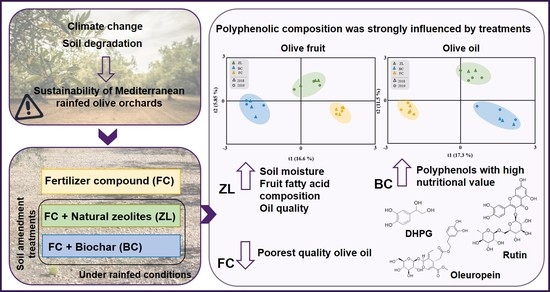Zeolites and Biochar Modulate Olive Fruit and Oil Polyphenolic Profile
Abstract
:1. Introduction
2. Materials and Methods
2.1. Site Characterization
2.2. Experimental Design
2.3. Sample Acquisition and Olive Yield
2.4. Fruit Biometric Variables and Maturation Index
2.5. Fruit Fat Content and Fatty Acid Profile Determination
2.6. Olive Oil Extraction and Quality Analyses
2.7. Extraction and Quantification of Polyphenolic Compounds from Olive Fruits and Olive Oil
2.8. High-Performance Liquid Chromatography (HPLC) Analysis of Olive Fruits and Oil Polyphenols
2.9. Statistical Analysis
3. Results and Discussion
3.1. Climate Data and Soil Moisture
3.2. Effect of Soil Treatments on Olive Yield, Fruit Biometric Variables and Maturation Index
3.3. Olive Fruit and Oil Metabolite Concentration under the Influence of Soil Conditioners
3.4. Influence of Soil Amendments on Olive Fruit and Oil Polyphenolic Composition
3.5. Olive Fruit Fat Content and Fatty Acid Profile under the Influence of Different Soil Conditioners
3.6. Impact of Soil Conditioners on Olive Oil Physico-Chemical Variables
4. Conclusions
Supplementary Materials
Author Contributions
Funding
Institutional Review Board Statement
Informed Consent Statement
Data Availability Statement
Conflicts of Interest
References
- Production Volume of Olive Oil Worldwide from 2012/13 to 2021/22 (in Million Metric Tons). Available online: https://www.statista.com/statistics/613466/olive-oil-production-volume-worldwide/ (accessed on 23 June 2022).
- Market Situation in the Olive Oil and Table Olives Sectors. Available online: https://ec.europa.eu/info/sites/default/files/food-farming-fisheries/plants_and_plant_products/documents/market-situation-olive-oil-table-olives_en.pdf (accessed on 23 June 2022).
- Consumption of Olive Oil Worldwide from 2012/13 to 2021/22 (in Million Metric Tons). Available online: https://www.statista.com/statistics/940491/olive-oil-consumption-worldwide/#:~:text=In%202021%2F22%2C%20the%20global,under%203.2%20million%20metric%20t (accessed on 23 June 2022).
- Brito, C.; Dinis, L.-T.; Moutinho-Pereira, J.; Correia, C.M. Drought Stress Effects and Olive Tree Acclimation under a Changing Climate. Plants 2019, 8, 232. [Google Scholar] [CrossRef] [PubMed] [Green Version]
- Jimenez-Lopez, C.; Carpena, M.; Lourenço-Lopes, C.; Gallardo-Gomez, M.; Lorenzo, J.M.; Barba, F.J.; Prieto, M.A.; Simal-Gandara, J. Bioactive Compounds and Quality of Extra Virgin Olive Oil. Foods 2020, 9, 1014. [Google Scholar] [CrossRef] [PubMed]
- Giuffrè, A.M. Influence of cultivar and harvest year on triglyceride composition of olive oils produced in Calabria (Southern Italy). Eur. J. Lipid Sci. Technol. 2013, 115, 928–934. [Google Scholar] [CrossRef]
- Kyçyk, O.; Aguilera, M.P.; Gaforio, J.J.; Jiménez, A.; Beltrán, G. Sterol composition of virgin olive oil of forty-three olive cultivars from the World Collection Olive Germplasm Bank of Cordoba. J. Sci. Food Agric. 2016, 96, 4143–4150. [Google Scholar] [CrossRef]
- Giuffrè, A. The effects of cultivar and harvest year on fatty alcohol composition of olive oils from South West Calabria (Italy). Grasas Aceites 2014, 65, 10. [Google Scholar] [CrossRef] [Green Version]
- Gandul-Rojas, B.; Roca, M.; Gallardo-Guerrero, L. Chlorophylls and carotenoids in food products from olive tree. In Products from Olive Tree; Books on Demand: Norderstedt, Germany, 2016; pp. 67–98. [Google Scholar]
- Giuffrè, A.M. n-Alkanes and n-Alkenes in Virgin Olive Oil from Calabria (South Italy): The Effects of Cultivar and Harvest Date. Foods 2021, 10, 290. [Google Scholar] [CrossRef]
- Tripoli, E.; Giammanco, M.; Tabacchi, G.; Di Majo, D.; Giammanco, S.; La Guardia, M. The phenolic compounds of olive oil: Structure, biological activity and beneficial effects on human health. Nutr. Res. Rev. 2005, 18, 98–112. [Google Scholar] [CrossRef]
- Cecchi, L.; Migliorini, M.; Mulinacci, N. Virgin Olive Oil Volatile Compounds: Composition, Sensory Characteristics, Analytical Approaches, Quality Control, and Authentication. J. Agric. Food Chem. 2021, 69, 2013–2040. [Google Scholar] [CrossRef]
- Romero-Segura, C.; García-Rodríguez, R.; Sanz, C.; Pérez, A.G. Virgin olive phenolic profile as a result of the anabolic and catabolic enzymes status in the olive fruit. Acta Hortic. 2011, 924, 379–384. [Google Scholar] [CrossRef] [Green Version]
- Guo, Z.; Jia, X.; Zheng, Z.; Lu, X.; Zheng, Y.; Zheng, B.; Xiao, J. Chemical composition and nutritional function of olive (Olea europaea L.): A review. Phytochem. Rev. 2018, 17, 1091–1110. [Google Scholar] [CrossRef]
- Sánchez-García, M.; Sánchez-Monedero, M.A.; Roig, A.; López-Cano, I.; Moreno, B.; Benitez, E.; Cayuela, M.L. Compost vs. biochar amendment: A two-year field study evaluating soil C build-up and N dynamics in an organically managed olive crop. Plant Soil 2016, 408, 1–14. [Google Scholar] [CrossRef]
- Shepherd, G.; Stagnari, F.; Pisante, M.; Benites, J. Olive Orchards; Food and Agriculture Organization of the United Nations, FAO: Rome, Italy, 2008. [Google Scholar]
- Gómez, J.A.; Infante-Amate, J.; De Molina, M.G.; Vanwalleghem, T.; Taguas, E.V.; Lorite, I. Olive Cultivation, its Impact on Soil Erosion and its Progression into Yield Impacts in Southern Spain in the Past as a Key to a Future of Increasing Climate Uncertainty. Agriculture 2014, 4, 170–198. [Google Scholar] [CrossRef] [Green Version]
- Cataldo, E.; Salvi, L.; Paoli, F.; Fucile, M.; Masciandaro, G.; Manzi, D.; Masini, C.M.; Mattii, G.B. Application of Zeolites in Agriculture and Other Potential Uses: A Review. Agronomy 2021, 11, 1547. [Google Scholar] [CrossRef]
- Ding, Y.; Liu, Y.; Liu, S.; Huang, X.; Li, Z.; Tan, X.; Zeng, G.; Zhou, L. Potential Benefits of Biochar in Agricultural Soils: A Review. Pedosphere 2017, 27, 645–661. [Google Scholar] [CrossRef]
- Zaidun, S.; Jalloh, M.B.; Awang, A.; Sam, L.; Awang Besar, N.; Musta, B.; Ahmed, O.; Omar, L. Biochar and clinoptilolite zeolite on selected chemical properties of soil cultivated with maize (Zea mays L.). Eurasian J. Soil Sci. 2019, 8, 1–10. [Google Scholar] [CrossRef]
- Ramesh, K.; Reddy, D.D. Chapter Four—Zeolites and Their Potential Uses in Agriculture. In Advances in Agronomy; Sparks, D.L., Ed.; Academic Press: Cambridge, MA, USA, 2011; pp. 219–241. [Google Scholar]
- Głąb, T.; Gondek, K.; Mierzwa-Hersztek, M. Biological effects of biochar and zeolite used for remediation of soil contaminated with toxic heavy metals. Sci. Rep. 2021, 11, 6998. [Google Scholar] [CrossRef]
- Szerement, J.; Ambrożewicz-Nita, A.; Kędziora, K.; Piasek, J. Use of Zeolite in Agriculture and Environmental Protection. A Short Review. Full Version: Contemporary applications of natural and synthetic zeolites from fly ash in agriculture and environmental protection. J. Clean. Prod. 2014, 781, 5. [Google Scholar] [CrossRef]
- Nakhli, S.A.; Delkash, M.; Bakhshayesh, B.; Kazemian, H. Application of Zeolites for Sustainable Agriculture: A Review on Water and Nutrient Retention. Water Air Soil Pollut. 2017, 228, 464. [Google Scholar] [CrossRef]
- Albuquerque, T.G.; Costa, H.S.; Oliveira, M.B.P.P. An Overview of Portuguese Olive Oils and Table Olives with Protected Designation of Origin. Eur. J. Lipid. Sci. Technol. 2019, 121, 1800129. [Google Scholar] [CrossRef]
- Van Reeuwijk, L.P. Procedures for Soil Analysis, 6th ed.; Technical Paper 9; ISRIC; FAO: Wageningen, The Netherlands, 2002. [Google Scholar]
- El Yamani, M.; Sakar, E.H.; Boussakouran, A.; Rharrabti, Y. Influence of ripening index and water regime on the yield and quality of “Moroccan Picholine” virgin olive oil. OCL 2020, 27, 19. [Google Scholar] [CrossRef]
- Folch, J.; Lees, M.; Sloane Stanley, G.H. A simple method for the isolation and purification of total lipides from animal tissues. J. Biol. Chem. 1957, 226, 12. [Google Scholar] [CrossRef]
- Regulation, C.I. IMPLEMENTING REGULATION (EU) 1348/2013 of 16 December 2013 amending Regulation (EEC) No 2568/91 on the Characteristics of Olive Oil and Olive-Residue Oil and on the Relevant Methods of Analysis, in 2568/91 2013: C.F.R. Available online: https://eur-lex.europa.eu/legal-content/GA/TXT/?uri=CELEX:32013R1348 (accessed on 23 June 2022).
- Brito, C.; Dinis, L.-T.; Silva, E.; Gonçalves, A.; Matos, C.; Rodrigues, M.A.; Moutinho-Pereira, J.; Barros, A.; Correia, C. Kaolin and salicylic acid foliar application modulate yield, quality and phytochemical composition of olive pulp and oil from rainfed trees. Sci. Hortic. 2018, 237, 176–183. [Google Scholar] [CrossRef] [Green Version]
- Kanakis, P.; Termentzi, A.; Michel, T.; Gikas, E.; Halabalaki, M.; Skaltsounis, A.L. From olive drupes to olive oil. An HPLC-orbitrap-based qualitative and quantitative exploration of olive key metabolites. Planta Med. 2013, 79, 1576–1587. [Google Scholar] [CrossRef] [PubMed] [Green Version]
- Tasioula-Margari, M.; Tsabolatidou, E. Extraction, Separation, and Identification of Phenolic Compounds in Virgin Olive Oil by HPLC-DAD and HPLC-MS. Antioxidants 2015, 4, 548–562. [Google Scholar] [CrossRef] [PubMed]
- Mondal, M.; Biswas, B.; Garai, S.; Sarkar, S.; Banerjee, H.; Brahmachari, K.; Bandyopadhyay, P.K.; Maitra, S.; Brestic, M.; Skalicky, M.; et al. Zeolites Enhance Soil Health, Crop Productivity and Environmental Safety. Agronomy 2021, 11, 448. [Google Scholar] [CrossRef]
- Litaor, M.I.; Katz, L.; Shenker, M. The influence of compost and zeolite co-addition on the nutrients status and plant growth in intensively cultivated Mediterranean soils. Soil Use Manag. 2017, 33, 72–80. [Google Scholar] [CrossRef] [Green Version]
- Rodrigues, M.Â.; Torres, L.; Damo, L.; Raimundo, S.; Sartor, L.; Cassol, L.C.; Arrobas, M. Nitrogen Use Efficiency and Crop Yield in Four Successive Crops Following Application of Biochar and Zeolites. J. Plant. Nutr. Soil Sci. 2021, 21, 1053–1065. [Google Scholar] [CrossRef]
- Vijay, V.; Shreedhar, S.; Adlak, K.; Payyanad, S.; Sreedharan, V.; Gopi, G.; Sophia van der Voort, T.; Malarvizhi, P.; Yi, S.; Gebert, J.; et al. Review of Large-Scale Biochar Field-Trials for Soil Amendment and the Observed Influences on Crop Yield Variations. Front. Energy Res. 2021, 9, 710766. [Google Scholar] [CrossRef]
- Haider, G.; Steffens, D.; Moser, G.; Müller, C.; Kammann, C.I. Biochar reduced nitrate leaching and improved soil moisture content without yield improvements in a four-year field study. Agric. Ecosyst. Environ. 2017, 237, 80–94. [Google Scholar] [CrossRef]
- Yadav, B.; Jogawat, A.; Rahman, M.S.; Narayan, O.P. Secondary metabolites in the drought stress tolerance of crop plants: A review. Gene Rep. 2021, 23, 101040. [Google Scholar] [CrossRef]
- Laxa, M.; Liebthal, M.; Telman, W.; Chibani, K.; Dietz, K.-J. The Role of the Plant Antioxidant System in Drought Tolerance. Antioxidants 2019, 8, 94. [Google Scholar] [CrossRef] [PubMed] [Green Version]
- Vinha, A.; Ferreres, F.; Silva, B.; Valentão, P.; Gonçalves, A.; Pereira, J.; Oliveira, M.; Seabra, R.; Andrade, P. Phenolic profiles of Portuguese olive fruits (Olea europaea L.): Influences of cultivar and geographical origin. Food Chem. 2005, 89, 561–568. [Google Scholar] [CrossRef]
- Mele, M.; Islam, M.; Kang, H.M.; Giuffrè, A. Pre-and post-harvest factors and their impact on oil composition and quality of olive fruit. Emir. J. Food Agric. 2018, 30, 592–603. [Google Scholar]
- Quartacci, M.F.; Sgherri, C.; Frisenda, S. Biochar amendment affects phenolic composition and antioxidant capacity restoring the nutraceutical value of lettuce grown in a copper-contaminated soil. Sci. Hortic. 2017, 215, 9–14. [Google Scholar] [CrossRef]
- Prinsi, B.; Negrini, N.; Morgutti, S.; Espen, L. Nitrogen Starvation and Nitrate or Ammonium Availability Differently Affect Phenolic Composition in Green and Purple Basil. Agronomy 2020, 10, 498. [Google Scholar] [CrossRef] [Green Version]
- Boccard, J.; Rutledge, D. A consensus orthogonal partial least squares discriminant analysis (OPLS-DA) strategy for multiblock Omics data fusion. Anal. Chim. Acta 2013, 769, 30–39. [Google Scholar] [CrossRef]
- Markhali, F.S. Effect of Processing on Phenolic Composition of Olive Oil Products and Olive Mill By-Products and Possibilities for Enhancement of Sustainable Processes. Processes 2021, 9, 953. [Google Scholar] [CrossRef]
- Talhaoui, N.; Gómez-Caravaca, A.M.; León, L.; De la Rosa, R.; Fernández-Gutiérrez, A.; Segura-Carretero, A. From Olive Fruits to Olive Oil: Phenolic Compound Transfer in Six Different Olive Cultivars Grown under the Same Agronomical Conditions. Int. J. Mol. Sci. 2016, 17, 337. [Google Scholar] [CrossRef] [Green Version]
- Bulotta, S.; Celano, M.; Lepore, S.M.; Montalcini, T.; Pujia, A.; Russo, D. Beneficial effects of the olive oil phenolic components oleuropein and hydroxytyrosol: Focus on protection against cardiovascular and metabolic diseases. J. Transl. Med. 2014, 12, 219. [Google Scholar] [CrossRef] [Green Version]
- Tsimidou, M.; Nenadis, N.; Servili, M.; Gonzáles, D.; Toschi, T. Why tyrosol derivatives have to be quantified in the calculation of “olive oil polyphenols” content to support the health claim provisioned in the EC Reg. 432/2012: Tyrosol and derivatives and the “olive oil polyphenol” health claim. Eur. J. Lipid Sci. Technol. 2018, 120, 1800098. [Google Scholar] [CrossRef] [Green Version]
- Dag, A.; Kerem, Z.; Yogev, N.; Zipori, I.; Lavee, S.; Ben-David, E. Influence of time of harvest and maturity index on olive oil yield and quality. Sci. Hortic. 2011, 127, 358–366. [Google Scholar] [CrossRef]
- Tsimidou, M.; Blekas, G.; Boskou, D. OLIVE OIL. In Encyclopedia of Food Sciences and Nutrition, 2nd ed.; Caballero, B., Ed.; Academic Press: Oxford, UK, 2003; pp. 4252–4260. [Google Scholar]
- Irmak, Ş.; Tokusoglu, O. Saturated and Unsaturated Fatty Acids Composition of Olive Oils Obtained from Less Salty Black Table Olives Preserved with Vacuum, MAP and Gamma Irradiation Technologies. Nutr. Food Sci. 2017, 7, 582. [Google Scholar] [CrossRef]
- Tekaya, M.; Mechri, B.; Dabbaghi, O.; Mahjoub, Z.; Laamari, S.; Chihaoui, B.; Boujnah, D.; Hammami, M.; Chehab, H. Changes in key photosynthetic parameters of olive trees following soil tillage and wastewater irrigation, modified olive oil quality. Agric. Water Manag. 2016, 178, 180–188. [Google Scholar] [CrossRef]
- Designations and Definitions of Olive Oils. Available online: https://www.internationaloliveoil.org/olive-world/olive-oil/ (accessed on 20 December 2021).
- Khaleghi, E.; Arzani, K.; Moallemi, N.; Barzegar, M. The efficacy of kaolin particle film on oil quality indices of olive trees (Olea europaea L.) cv ‘Zard’ grown under warm and semi-arid region of Iran. Food Chem. 2015, 166, 35–41. [Google Scholar] [CrossRef] [PubMed]
- Berenguer, M.; Vossen, P.; Grattan, S.; Connell, J.; Polito, V. Tree Irrigation Levels for Optimum Chemical and Sensory Properties of Olive Oil. HortScience 2006, 41, 427–432. [Google Scholar] [CrossRef] [Green Version]
- Palese, A.; Nuzzo, V.; Favati, F.; Pietrafesa, A.; Celano, G.; Xiloyannis, C. Effects of water deficit on the vegetative response, yield and oil quality of olive trees (Olea europaea L.; cv Coratina) grown under intensive cultivation. Sci. Hortic. 2010, 125, 222–229. [Google Scholar] [CrossRef]
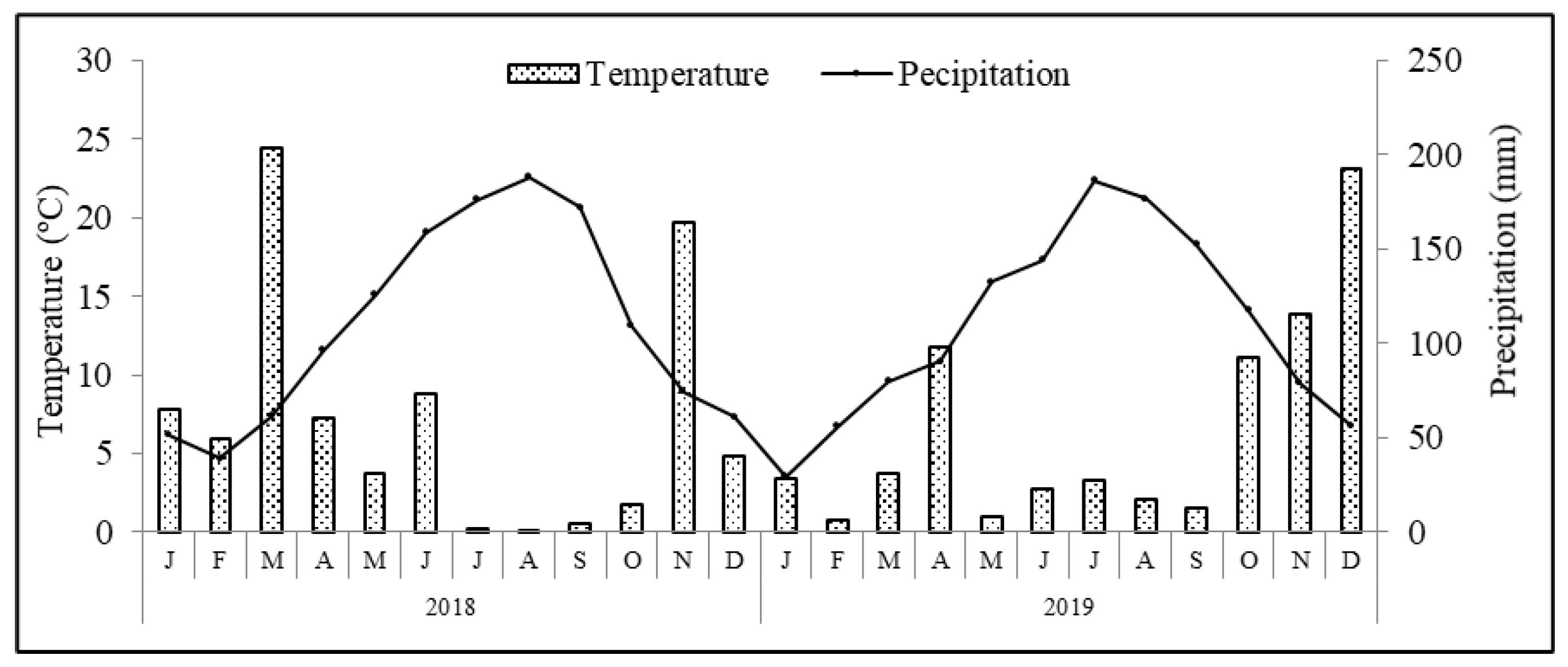
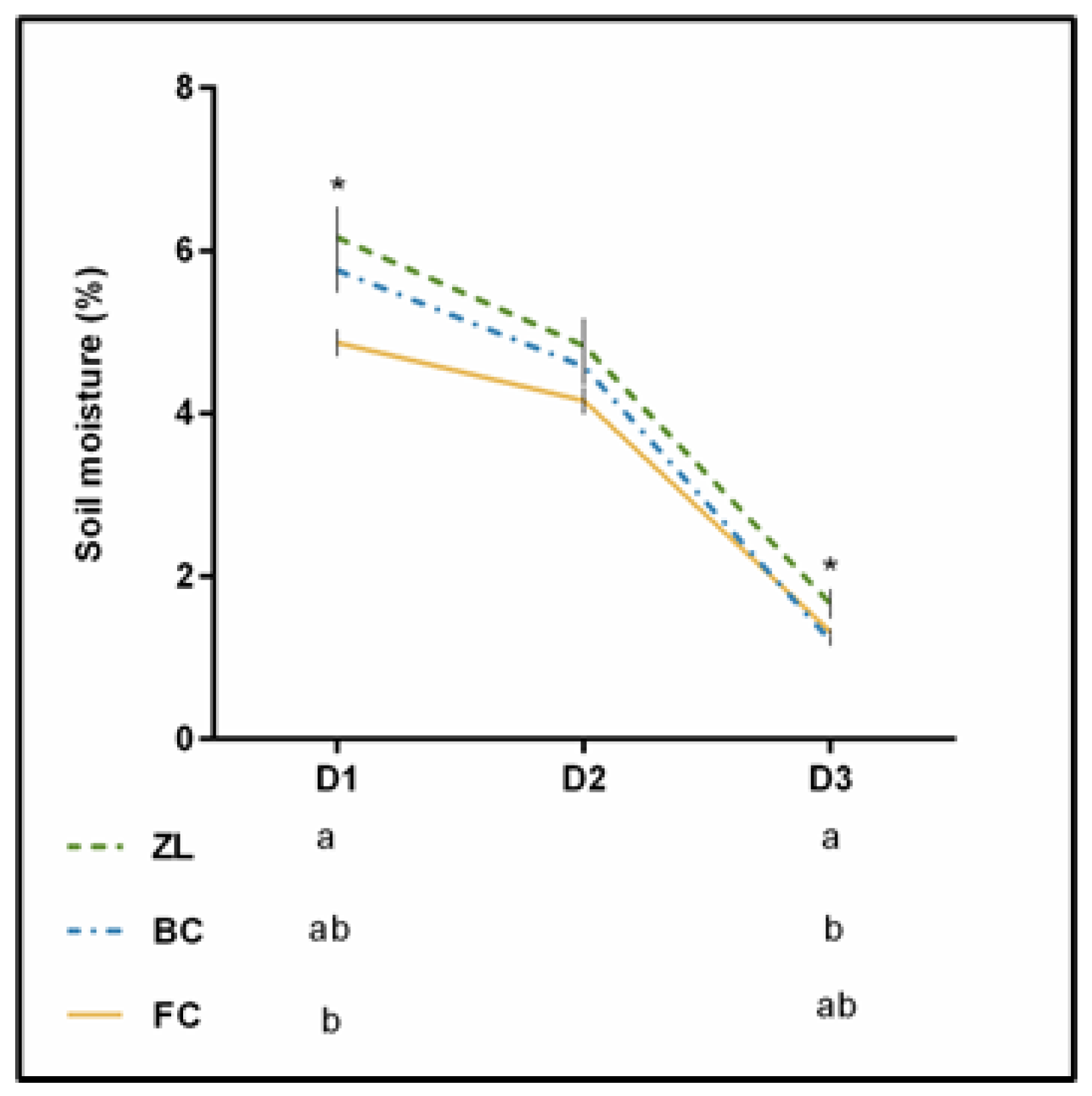
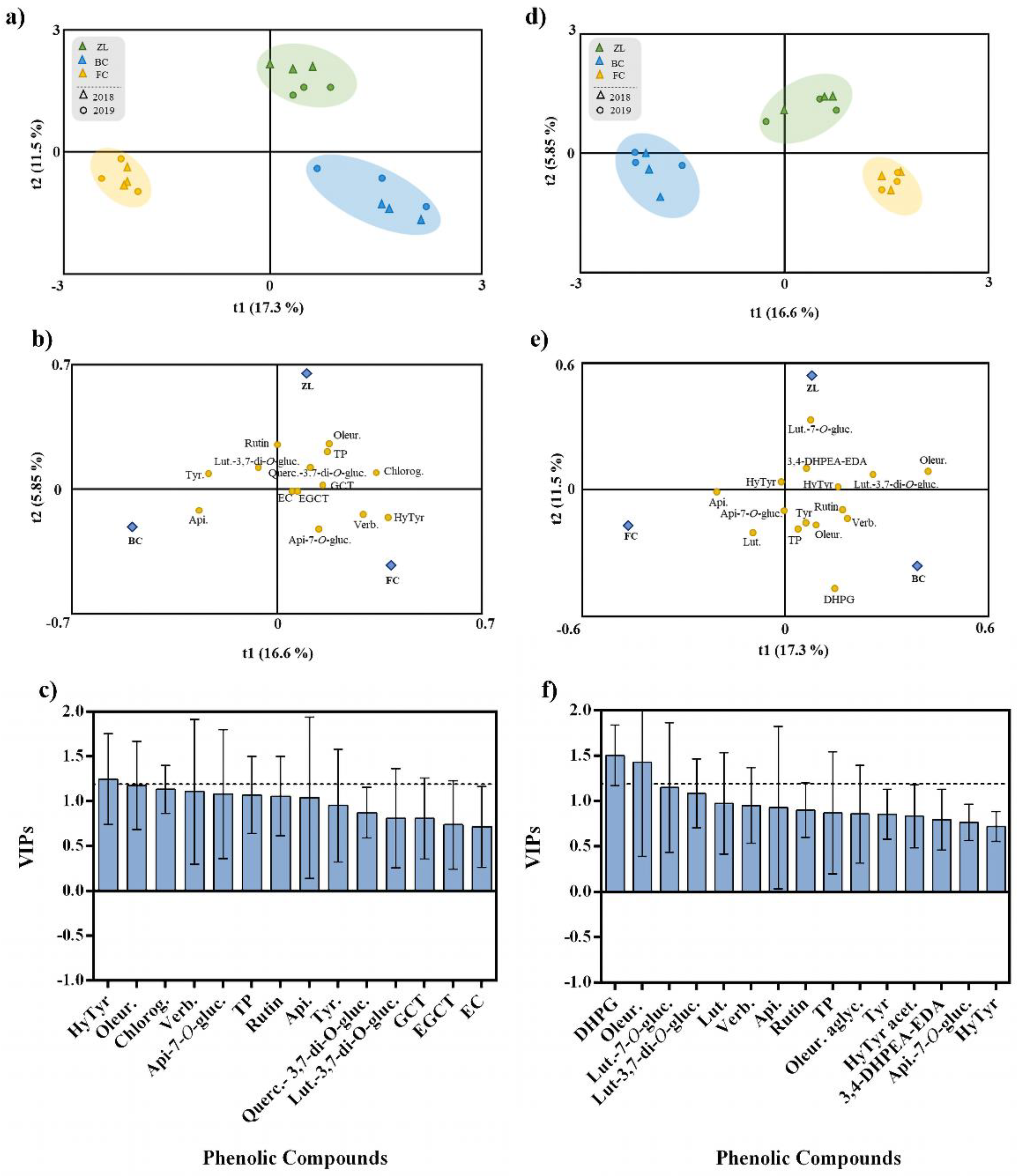
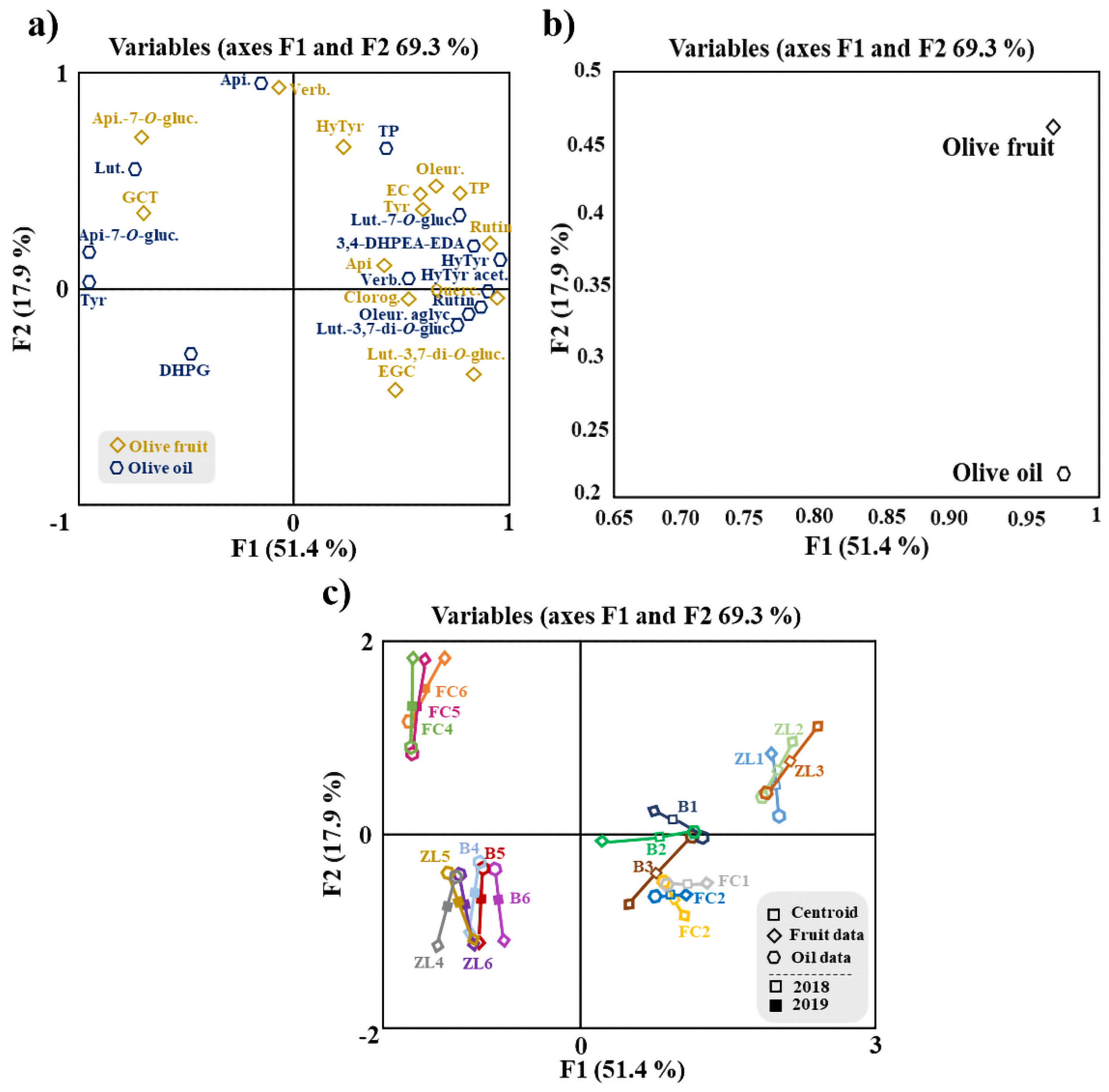
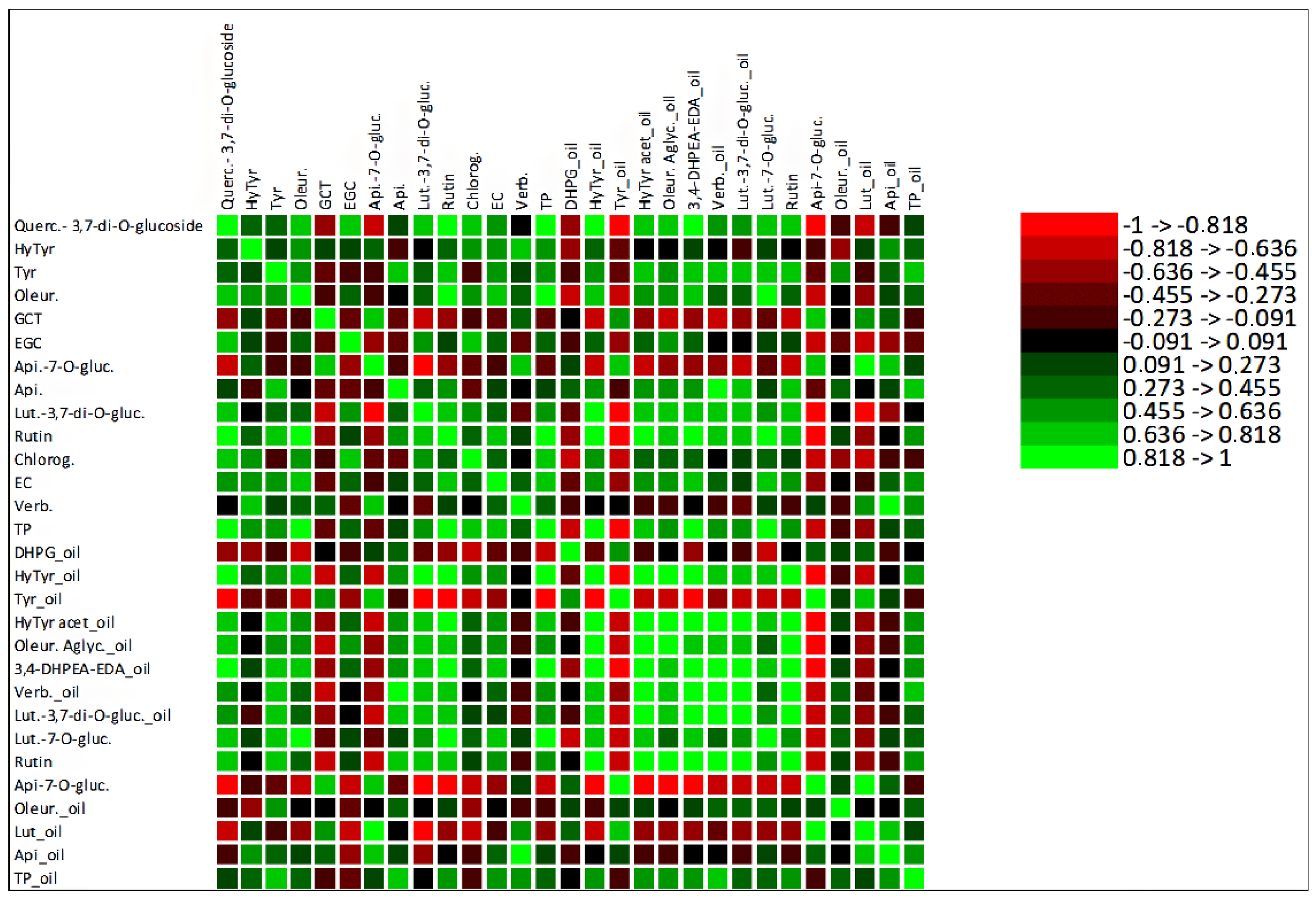
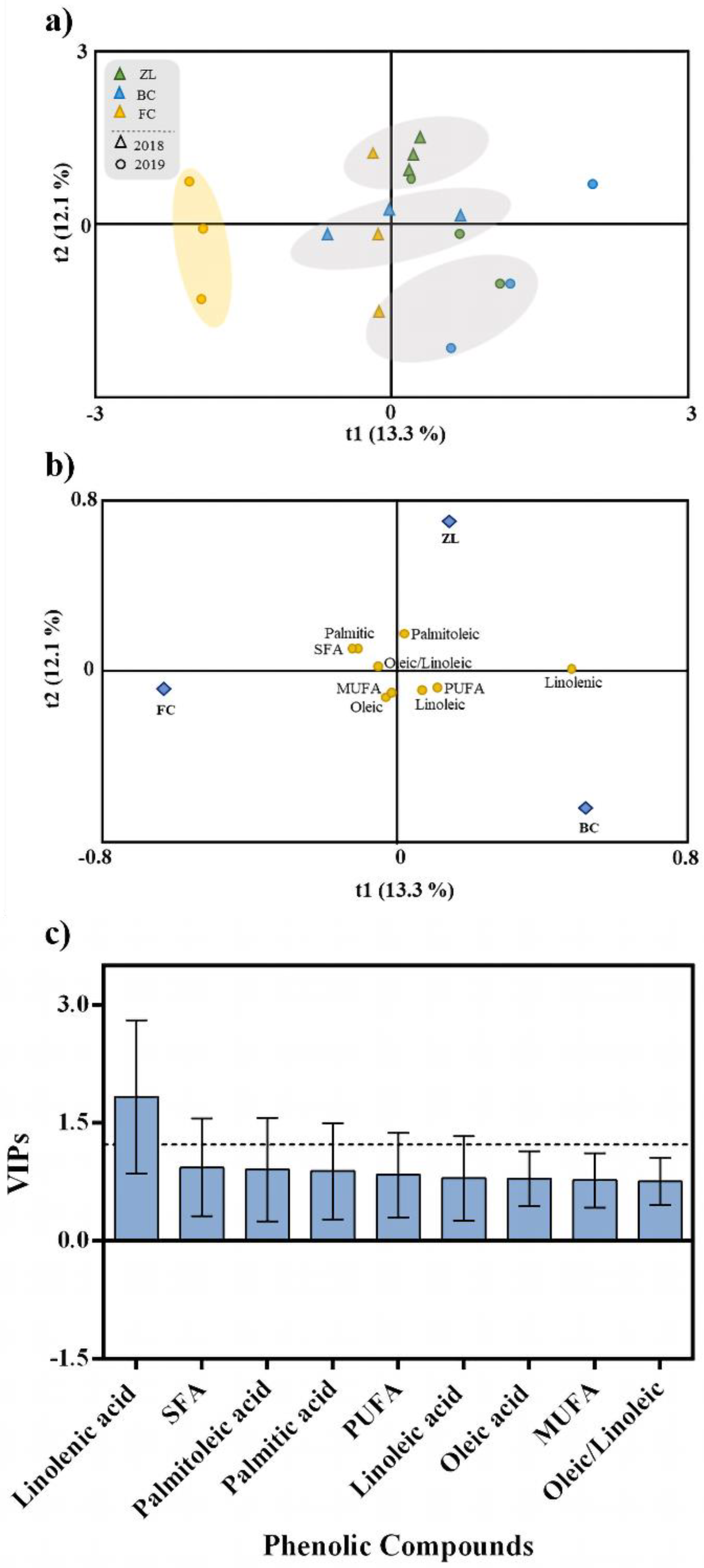
| T Mean (°C) | T Máx (°C) | T Min (°C) | T Mean (May–October) (°C) | Ʃ Precep. (mm) | Ʃ Precep. (May–October) (mm) | |
|---|---|---|---|---|---|---|
| 2018 | 13.2 | 39.1 | −7.9 | 18.6 | 708.4 | 125.8 |
| 2019 | 13.0 | 34.3 | −7.9 | 18.2 | 652.2 | 179.8 |
| Zeolites | Biochar | ||
|---|---|---|---|
| Particle size | 0.6–1.5 mm | Particle size | 0.1–10 mm |
| Bulk density | 2000–2400 kg m−3 | Bulk density | 350–400 kg m−3 |
| Cation-Exchange capacity | 1.5–1.9 meq g−1 | Moisture | ≤30.0 |
| Porosity | 45.0–50.0% | Conductivity | 948 µs cm−1 |
| pH | 7.0–8.0 | pH | ˂9.0 |
| Specific surface | 70.0–80.0 m2 g−1 | Total organic C | ≥90.0% |
| SiO2 | 65.0–72.0% | Ash | ≤5.0% |
| Al2O3 | 10.0–12.0% | Volatile | ≤5.0% |
| CaO | 2.5–3.7% | Total N | ≤5.0 g kg−1 |
| K2O | 2.3–3.5% | Cd | ˂0.05 mg kg−1 |
| Fe2O3 | 0.8–1.9% | Pb | 0.05 mg kg−1 |
| MgO | 0.9–1.2% | Fe | 99.5 mg kg−1 |
| Na2O | 0.3–0.65% | As | ˂0.10 mg kg−1 |
| TiO2 | 0.0–0.10% | Hg | ˂0.10 mg kg−1 |
| Crop Yield (kg tree−1) | Fruit FW (g) | Pulp FW (g) | Pit FW (g) | Equat. Length (mm) | Long. Length (mm) | Pulp/Pit Ratio | |
|---|---|---|---|---|---|---|---|
| 2018 | |||||||
| FC | 9.11 ± 1.54 | 3.53 ± 0.147 a | 2.69 ± 0.123 | 0.843 ± 0.026 | 16.1 ± 0.200 a | 22.5 ± 0.331 a | 3.24 ± 0.168 |
| ZL | 11.4 ± 1.19 | 3.08 ± 0.136 b | 2.28 ± 0.114 | 0.799 ± 0.025 | 15.3 ± 0.226 b | 21.3 ± 0.361 b | 2.83 ± 0.080 |
| BC | 10.8 ± 1.81 | 3.54 ± 0.150 a | 2.65 ± 0.129 | 0.885 ± 0.024 | 16.1 ± 0.217 a | 22.0 ± 0.376 ab | 2.98 ± 0.107 |
| One-way ANOVA | n.s. | 0.040 | n.s. | n.s. | 0.011 | 0.050 | n.s. |
| 2019 | |||||||
| FC | 12.8 ± 1.55 | 4.27 ± 0.124 | 3.44 ± 0.107 | 0.829 ± 0.026 | 16.8 ± 0.188 | 24.3 ± 0.304 | 4.19 ± 0.109 ab |
| ZL | 10.9 ± 1.39 | 4.54 ± 0.143 | 3.71 ± 0.119 | 0.832 ± 0.027 | 17.5 ± 0.183 | 23.7 ± 0.263 | 4.47 ± 0.065 a |
| BC | 15.5 ± 2.81 | 4.19 ± 0.136 | 3.34 ± 0.117 | 0.830 ± 0.023 | 17.2 ± 0.198 | 23.6 ± 0.329 | 4.05 ± 0.085 b |
| One-way ANOVA | n.s. | n.s. | n.s. | n.s. | n.s. | n.s. | 0.004 |
| Two-way ANOVA | |||||||
| Year | n.s. | p < 0.0001 | p < 0.0001 | n.s. | p < 0.0001 | 0.017 | p < 0.0001 |
| Treatment | n.s. | n.s. | n.s. | n.s. | n.s. | p < 0.0001 | n.s. |
| Year × Treatment | n.s. | 0.007 | 0.004 | n.s. | 0.002 | n.s. | 0.0004 |
| Olive Fruits | Olive Oil | |||||
|---|---|---|---|---|---|---|
| Ortho-Diphenols | Flavonoids | TAC | Ortho-Diphenols | Flavonoids | TAC | |
| 2018 | ||||||
| FC | 41.9 ± 2.19 a | 23.1 ± 2.02 | 33.7 ± 1.11 a | 59.8 ± 2.22 b | 36.2 ± 7.06 b | 113.2 ± 2.87 b |
| ZL | 41.8 ± 1.79 a | 24.0 ± 1.73 | 30.9 ± 2.49 a | 54.7 ± 1.09 b | 35.4 ± 4.75 b | 123.6 ± 1.66 b |
| BC | 30.8 ± 1.74 b | 17.5 ± 1.93 | 14.7 ± 1.76 b | 110.1 ± 2.54 a | 150.3 ± 15.6 a | 186.2 ± 4.46 a |
| One-way ANOVA | 0.001 | n.s. | p < 0.0001 | p < 0.0001 | p < 0.0001 | p < 0.0001 |
| 2019 | ||||||
| FC | 14.8 ± 0.933 b | 29.2 ± 3.27 b | 84.8 ± 3.04 b | 57.9 ± 0.918 ab | 77.7 ± 3.30 b | 249.4 ± 5.72 c |
| ZL | 12.8 ± 0.908 b | 32.8 ± 2.99 b | 98.9 ± 3.02 a | 62.2 ± 0.795 a | 109.7 ± 3.37 a | 307.7 ± 7.14 a |
| BC | 22.1 ± 1.37 a | 67.3 ± 5.77 a | 110.3 ± 5.11 a | 54.1 ± 2.68 b | 105.6 ± 1.75 a | 276.0 ± 7.75 b |
| One-way ANOVA | p < 0.0001 | p < 0.0001 | 0.001 | 0.024 | p < 0.0001 | p < 0.0001 |
| Two-way ANOVA | ||||||
| Year | p < 0.0001 | 0.0001 | p < 0.0001 | p < 0.0001 | p < 0.0001 | p < 0.0001 |
| Treatment | n.s. | 0.01 | n.s. | p < 0.0001 | p < 0.0001 | p < 0.0001 |
| Year × Treatment | p < 0.0001 | 0.0005 | p < 0.0001 | p < 0.0001 | p < 0.0001 | p < 0.0001 |
| Non-Flavonoid Composition | Flavonoid Composition | TP | ||||||||||||
|---|---|---|---|---|---|---|---|---|---|---|---|---|---|---|
| HyTyr | Tyr | Chlorog. | Verb. | Oleur. | GCT | EGCT | EC | Querc. | Lut-3,7-di-O-gluc. | Rutin | Api-7-O-gluc. | Api. | ||
| 2018 | ||||||||||||||
| FC | 464.5 ± 7.62 | 9.39 ± 0.254 b | 256.7 ± 22.2 a | 175.7 ± 9.06 b | 2271.4 ± 84.4 b | 83.6 ± 6.38 | 243.8 ± 16.9 a | 134.9 ± 7.63 ab | 81.9 ± 2.19 a | 1630.1 ± 113.8 | 657.6 ± 77.2 b | 55.6 ± 6.19 b | 18.4 ± 1.15 b | 6319.4 ± 58.6 b |
| ZL | 459.0 ± 10.1 | 26.0 ± 0.698 a | 215.4 ± 6.14 a | 250.7 ± 25.7 a | 4274.0 ± 193.9 a | 88.5 ± 4.78 | 174.3 ± 5.30 b | 153.4 ± 5.07 a | 85.2 ± 0.239 a | 1541.1 ± 87.9 | 1100.2 ± 1.06 a | 83.9 ± 8.11 a | 21.9 ± 0.977 b | 8648.9 ± 271.0 a |
| BC | 340.3 ± 81.2 | 28.8 ± 2.88 a | 93.0 ± 3.66 b | 167.2 ± 1.59 b | 1471.9 ± 170.7 c | 82.5 ± 10.9 | 78.7 ± 7.54 c | 129.5 ± 0.911 b | 52.9 ± 2.06 b | 1527.7 ± 69.8 | 785.2 ± 42.4 b | 95.9 ± 3.02 a | 42.8 ± 0.922 a | 5003.1 ± 200.2 c |
| One-way ANOVA | n.s. | p < 0.0001 | p < 0.0001 | 0.018 | p < 0.0001 | n.s. | p < 0.0001 | 0.043 | p < 0.0001 | n.s. | 0.002 | 0.009 | p < 0.0001 | p < 0.0001 |
| 2019 | ||||||||||||||
| FC | 494.9 ± 7.16 a | 13.9 ± 0.141 a | 127.1 ± 3.53 ab | 407.9 ± 5.30 a | 1688.9 ± 44.2 a | 115.2 ± 6.11 a | 58.5 ± 3.32 c | 131.8 ± 1.68 a | 26.9 ± 0.170 b | 652.1 ± 8.80 b | 364.2 ± 12.5 a | 157.0 ± 2.72 b | 18.8 ± 0.437 | 4657.0 ± 39.0 a |
| ZL | 328.5 ± 16.2 b | 8.89 ± 0.403 b | 146.0 ± 5.73 a | 105.4 ± 5.17 b | 1031.2 ± 27.9 b | 106.1 ± 1.64 ab | 106.2 ± 2.15 b | 109.5 ± 3.11 b | 33.5 ± 0.789 a | 1162.2 ± 42.5 a | 381.9 ± 11.9 a | 126.1 ± 4.47 c | 15.2 ± 2.21 | 3832.2 ± 107.2 b |
| BC | 296.3 ± 7.26 b | 13.8 ± 0.635 a | 106.7 ± 7.34 b | 95.6 ± 4.85 b | 996.8 ± 49.1 b | 94.6 ± 1.69 b | 179.7 ± 4.19 a | 129.2 ± 4.72 a | 33.1 ± 0.237 a | 1074.1 ± 100.1 a | 317.4 ± 5.63 b | 392.7 ± 0.114 a | 16.0 ± 1.10 | 3679.1 ± 85.8 b |
| One-way ANOVA | p < 0.0001 | p < 0.0001 | 0.009 | p < 0.0001 | p < 0.0001 | 0.024 | p < 0.0001 | 0.007 | p < 0.0001 | 0.003 | 0.012 | p < 0.0001 | n.s. | p < 0.0001 |
| Two-way ANOVA | ||||||||||||||
| Year | n.s. | p < 0.001 | p < 0.001 | n.s. | p < 0.001 | 0.002 | p < 0.001 | 0.001 | p < 0.001 | p < 0.001 | p < 0.001 | p < 0.001 | p < 0.001 | p < 0.001 |
| Treatment | 0.002 | p < 0.001 | p < 0.001 | p < 0.001 | p < 0.001 | n.s. | n.s. | n.s. | p < 0.001 | n.s. | p < 0.001 | p < 0.001 | p < 0.001 | p < 0.001 |
| Year × Treatment | n.s. | p < 0.001 | p < 0.001 | p < 0.001 | p < 0.001 | n.s. | p < 0.001 | 0.0006 | p < 0.001 | 0.005 | 0.0003 | p < 0.001 | p < 0.001 | p < 0.001 |
| Non-Flavonoid Composition | Flavonoid Composition | TP | |||||||||||||
|---|---|---|---|---|---|---|---|---|---|---|---|---|---|---|---|
| DHPG | HyTyr | Tyr | HyTyr Acet. | Oleur. Aglyc. | 3,4-DHPEA-EDA | Verb. | Oleur. | Lut.7-O-gluc. | Lut.-3,7-di-O-gluc. | Rutin | Api-7-O-gluc. | Lut. | Api. | ||
| 2018 | |||||||||||||||
| FC | 0.161 ± 0.004 b | 0.048 ± 0.0002 b | 0.194 ± 0.0006 b | 0.059 ± 0.001 | 13.5 ± 0.202 | 0.558 ± 0.001 c | 0.271 ± 0.001 b | 0.530 ± 0.276 b | 0.030 ± 0.002 c | 0.175 ± 0.0002 c | 1.65 ± 0.010 c | 0.211 ± 0.005 b | 11.4 ± 0.128 b | 6.39 ± 0.151 c | 52.5 ± 0.384 c |
| ZL | 0.089 ± 0.003 c | 0.052 ± 0.0004 a | 0.075 ± 0.006 c | 0.077 ± 0.001 | 13.1 ± 0.095 | 0.957 ± 0.009 a | 0.299 ± 0.007 c | 1.17 ± 0.022 a | 0.311 ± 0.001 a | 0.234 ± 0.004 b | 1.72 ± 0.019 b | 0.149 ± 0.004 c | 11.3 ± 0.749 b | 7.95 ± 0.165 a | 61.1 ± 0.325 b |
| BC | 0.205 ± 0.002 a | 0.045 ± 0.001 c | 0.530 ± 0.035 a | 0.074 ± 0.003 | 13.6 ± 0.472 | 0.700 ± 0.001 b | 0.402 ± 0.005 a | 1.26 ± 0.025 a | 0.070 ± 0.001 b | 0.264 ± 0.009 a | 1.86 ± 0.014 a | 0.915 ± 0.003 a | 17.5 ± 0.499 a | 7.35 ± 0.44 b | 64.5 ± 0.471 a |
| One-way ANOVA | p < 0.0001 | 0.002 | p < 0.0001 | n.s. | n.s. | p < 0.0001 | p < 0.0001 | p < 0.0001 | p < 0.0001 | p < 0.0001 | p < 0.0001 | p < 0.0001 | p < 0.0001 | p < 0.0001 | p < 0.0001 |
| 2019 | |||||||||||||||
| FC | 0.171 ± 0.007 b | 0.012 ± 0.0003 | 1.01 ± 0.026 | 0.033 ± 0.002 b | 8.68 ± 0.523 b | 0.045 ± 0.002 b | 0.176 ± 0.005 | 0.872 ± 0.014 b | 0.009 ± 0.0001 | 0.103 ± 0.002 c | 1.33 ± 0.010 b | 2.42 ± 0.052 a | 27.2 ± 1.16 a | 9.80 ± 0.425 a | 60.4 ± 1.55 a |
| ZL | 0.147 ± 0.001 b | 0.011 ± 0.001 | 0.849 ± 0.016 | 0.034 ± 0.002 b | 7.57 ± 0.054 b | 0.041 ± 0.002 b | 0.173 ± 0.006 | 1.09 ± 0.049 ab | 0.016 ± 0.004 | 0.173 ± 0.001 a | 1.35 ± 0.004 b | 1.86 ± 0.014 b | 16.1 ± 0.785 b | 6.29 ± 0.129 b | 44.2 ± 0.458 c |
| BC | 0.212 ± 0.016 a | 0.013 ± 0.0003 | 0.969 ± 0.069 | 0.047 ± 0.002 a | 11.4 ± 0.416 a | 0.077 ± 0.006 a | 0.198 ± 0.009 | 1.15 ± 0.079 a | 0.008 ± 0.0001 | 0.142 ± 0.008 b | 1.47 ± 0.013 a | 1.79 ± 0.125 b | 17.8 ± 0.045 b | 6.38 ± 0.183 b | 53.8 ± 0.602 b |
| One-way ANOVA | 0.012 | n.s. | n.s. | 0.001 | 0.001 | 0.001 | n.s. | 0.026 | n.s. | p < 0.0001 | p < 0.0001 | 0.003 | p < 0.0001 | p < 0.0001 | p < 0.0001 |
| Two-way ANOVA | |||||||||||||||
| Year | 0.002 | p < 0.001 | p < 0.001 | p < 0.001 | p < 0.001 | p < 0.001 | p < 0.001 | n.s. | p < 0.001 | p < 0.001 | p < 0.001 | p < 0.001 | p < 0.001 | n.s. | p < 0.001 |
| Treatment | p < 0.0001 | 0.0027 | p < 0.001 | 0.0035 | 0.0001 | p < 0.001 | p < 0.001 | p < 0.0001 | p < 0.001 | p < 0.001 | p < 0.001 | p < 0.001 | p < 0.001 | 0.0002 | p < 0.001 |
| Year × Treatment | 0.009 | p < 0.001 | 0.0002 | 0.047 | 0.001 | p < 0.001 | p < 0.001 | 0.0003 | p < 0.001 | p < 0.001 | n.s. | p < 0.001 | p < 0.001 | p < 0.0001 | p < 0.001 |
| Fat Content | Palmitic Acid | Palmitoleic Acid | Oleic Acid | Linoleic Acid | Linolenic Acid | SFA | MUFA | PUFA | Oleic/Linoleic | |
|---|---|---|---|---|---|---|---|---|---|---|
| 2018 | ||||||||||
| FC | 56.4 ± 0.742 | 14.4 ± 0.395 | 0.909 ± 0.049 | 72.3 ± 0.162 b | 9.24 ± 0.189 a | 0.649 ± 0.008 | 16.7 ± 0.305 | 73.4 ± 0.115 b | 9.89 ± 0.181 a | 7.84 ± 0.143 b |
| ZL | 56.9 ± 0.376 | 14.1 ± 0.020 | 0.992 ± 0.002 | 73.4 ± 0.114 a | 8.32 ± 0.112 b | 0.666 ± 0.003 | 16.5 ± 0.013 | 74.5 ± 0.123 a | 8.99 ± 0.109 b | 8.81 ± 0.132 a |
| BC | 60.6 ± 1.98 | 14.4 ± 0.109 | 1.03 ± 0.039 | 72.0 ± 0.141 b | 9.41 ± 0.083 a | 0.647 ± 0.013 | 16.9 ± 0.127 | 73.2 ± 0.109 b | 10.1 ± 0.090 a | 7.66 ± 0.079 b |
| One-way ANOVA | n.s. | n.s. | n.s. | 0.001 | 0.003 | n.s. | n.s. | p < 0.0001 | 0.003 | 0.001 |
| 2019 | ||||||||||
| FC | 60.3 ± 1.01 a | 13.3 ± 0.034 a | 0.781 ± 0.022 | 75.9 ± 0.483 a | 7.67 ± 0.157 | 0.549 ± 0.001 b | 15.7 ± 0.086 a | 76.8 ± 0.471 b | 8.22 ± 0.158 | 9.91 ± 0.140 |
| ZL | 56.1 ± 0.440 b | 13.3 ± 0.081 a | 0.841 ± 0.040 | 73.8 ± 0.255 b | 8.56 ± 0.326 | 0.684 ± 0.017 a | 15.9 ± 0.044 a | 74.9 ± 0.299 c | 9.24 ± 0.342 | 8.65 ± 0.359 |
| BC | 62.4 ± 0.718 a | 12.5 ± 0.197 b | 0.724 ± 0.032 | 76.7 ± 0.147 a | 7.88 ± 0.386 | 0.711 ± 0.021 a | 14.9 ± 0.152 b | 77.6 ± 0.105 a | 8.59 ± 0.364 | 9.79 ± 0.469 |
| One-way ANOVA | 0.003 | 0.007 | n.s. | 0.002 | n.s. | 0.001 | 0.001 | 0.003 | n.s. | n.s. |
| Two-way ANOVA | ||||||||||
| Year | n.s. | p < 0.0001 | p < 0.0001 | p < 0.0001 | 0.0003 | n.s. | p < 0.0001 | p < 0.0001 | 0.0003 | p < 0.0001 |
| Treatment | 0.0013 | n.s. | n.s. | 0.027 | n.s. | p < 0.0001 | n.s. | 0.038 | n.s. | n.s. |
| Year × Treatment | n.s. | 0.038 | 0.042 | p < 0.0001 | 0.003 | 0.0001 | 0.0009 | p < 0.0001 | 0.003 | 0.001 |
| FA | PI | K232 | K270 | ∆K | |
|---|---|---|---|---|---|
| 2018 | |||||
| FC | 0.221 ± 0.0002 b | 20.2 ± 0.735 a | 2.18 ± 0.092 a | 0.119 ± 0.002 ab | 0.004 ± 0.0002 ab |
| ZL | 0.201 ± 0.0002 c | 9.79 ± 0.864 b | 2.06 ± 0.016 a | 0.113 ± 0.003 b | 0.003 ± 0.00002 b |
| BC | 0.279 ± 0.001 a | 10.4 ± 0.568 b | 1.68 ± 0.051 b | 0.133 ± 0.006 a | 0.0004 ± 0.0001 a |
| One-way ANOVA | p < 0.0001 | p < 0.0001 | 0.003 | 0.040 | 0.030 |
| 2019 | |||||
| FC | 0.161 ± 0.0001 a | 2.54 ± 0.209 a | 2.92 ± 0.006 a | 0.185 ± 0.001 | 0.004 ± 0.0002 |
| ZL | 0.121 ± 0.0001 b | 1.69 ± 0.004 b | 2.46 ± 0.054 b | 0.181 ± 0.001 | 0.038 ± 0.00001 |
| BC | 0.121 ± 0.0001 b | 2.50 ± 0.052 a | 2.67 ± 0.125 ab | 0.188 ± 0.002 | 0.004 ± 0.0001 |
| One-way ANOVA | p < 0.0001 | 0.005 | 0.017 | 0.053 | n.s. |
| Two-way ANOVA | |||||
| Year | p < 0.0001 | p < 0.0001 | p < 0.0001 | p < 0.0001 | 0.0015 |
| Treatment | p < 0.0001 | p < 0.0001 | 0.0005 | 0.0040 | 0.0049 |
| Year × Treatment | p < 0.0001 | p < 0.0001 | 0.005 | n.s. | n.s. |
Publisher’s Note: MDPI stays neutral with regard to jurisdictional claims in published maps and institutional affiliations. |
© 2022 by the authors. Licensee MDPI, Basel, Switzerland. This article is an open access article distributed under the terms and conditions of the Creative Commons Attribution (CC BY) license (https://creativecommons.org/licenses/by/4.0/).
Share and Cite
Martins, S.; Silva, E.; Brito, C.; Martins-Gomes, C.; Gonçalves, A.; Arrobas, M.; Rodrigues, M.Â.; Correia, C.M.; Nunes, F.M. Zeolites and Biochar Modulate Olive Fruit and Oil Polyphenolic Profile. Antioxidants 2022, 11, 1332. https://doi.org/10.3390/antiox11071332
Martins S, Silva E, Brito C, Martins-Gomes C, Gonçalves A, Arrobas M, Rodrigues MÂ, Correia CM, Nunes FM. Zeolites and Biochar Modulate Olive Fruit and Oil Polyphenolic Profile. Antioxidants. 2022; 11(7):1332. https://doi.org/10.3390/antiox11071332
Chicago/Turabian StyleMartins, Sandra, Ermelinda Silva, Cátia Brito, Carlos Martins-Gomes, Alexandre Gonçalves, Margarida Arrobas, Manuel Ângelo Rodrigues, Carlos M. Correia, and Fernando M. Nunes. 2022. "Zeolites and Biochar Modulate Olive Fruit and Oil Polyphenolic Profile" Antioxidants 11, no. 7: 1332. https://doi.org/10.3390/antiox11071332
APA StyleMartins, S., Silva, E., Brito, C., Martins-Gomes, C., Gonçalves, A., Arrobas, M., Rodrigues, M. Â., Correia, C. M., & Nunes, F. M. (2022). Zeolites and Biochar Modulate Olive Fruit and Oil Polyphenolic Profile. Antioxidants, 11(7), 1332. https://doi.org/10.3390/antiox11071332










